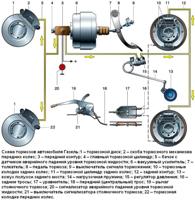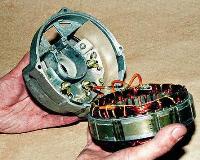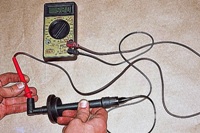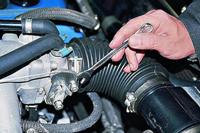The technical condition of the engine is constantly changing during operation
During the break-in period (about 2000 km), as the rubbing surfaces run in, friction losses decrease, engine power increases, fuel consumption decreases, and oil waste decreases.
Next comes a period in which the technical condition practically changes little.
As the parts wear, the breakthrough of gases through the piston rings increases, the compression in the cylinders decreases, the leakage of oil through the gaps in the joints increases and the pressure in the system drops.
Consequently, engine power gradually decreases, fuel consumption increases, oil consumption increases.
Determining the technical condition of the engine for timely reconditioning is very important.
This will extend the overall life of the engine and prevent engine failure.
The condition of the engine is assessed by the indicators of instruments (coolant temperature and oil pressure), the nature of the engine in various modes (uniformity, noise qualities), by the amount of compression in the engine cylinders, the car's response to a change in the fuel supply by the accelerator pedal.
A drop in engine power is manifested in a decrease in the dynamic qualities of the car, in a deterioration in throttle response.
The car accelerates sluggishly, climbs with difficulty (you have to downshift prematurely), does not develop maximum speed.
It should be borne in mind that these signs may also be the result of a violation of the adjustment of the mechanisms of the chassis of the car.
Free rolling path (coast) of a serviceable car, with a full load, moving at a speed of 50 km / h, must be at least 550 m.
Such a test is carried out in calm weather on a dry horizontal section of the highway with asphalt or concrete pavement.
Fuel consumption (operational) depends not only on the technical condition of the engine, but also (if the chassis of the car is in good condition) on road conditions, load, driving methods, therefore, operational fuel consumption is not an objective indicator of the technical condition of the engine.
The technical condition of the engine (if other vehicle mechanisms are in good condition) is determined by the control fuel consumption when driving a fully loaded vehicle along a horizontal section of a highway with asphalt or concrete coating at a speed of 60 km/h.
The test is carried out on a section 4-5 km long in two opposite directions.
The control consumption for a run-in car should not exceed 11 liters per 100 km.
When determining the control consumption of gasoline, use a separate measuring tank.
Compression in engine cylinders
Checking the compression (pressure) in the cylinders at the end of the compression stroke is done with a compression gauge.
Before measuring, it is necessary to check the correctness of the thermal clearances in the valves and adjust if necessary.
The compression in the cylinders is measured with the engine warmed up to 70-85 ° C with the carburetor throttle fully open and the candles turned out, while the carburetor should be without fuel.
The rubber tip of the compression tester is inserted into the hole of the spark plug of the first cylinder, providing a seal along the edge of the hole, and the engine crankshaft is rotated by the starter until the pressure in the cylinder stops increasing (but no more than 10-15 seconds).
The battery must be in good condition and fully charged.
Compression in the cylinders for the 4026 engine is less than 850 kPa (8.5 kgf/cm 2) and for the 4025 engine less than 800 kPa (8 kgf/cm 2) indicates about wear or malfunction of the piston rings or about leaks in the valve seat.
To establish the true cause of the malfunction, pour 20-30 cm 3 of oil used for the engine through the candle hole into each cylinder and check the compression again.
Increase in compression indicates a malfunction (wear) of the rings or cylinder; if the compression value has not increased, then, therefore, the tightness of the valve seat is broken.
Oil consumption for waste is controlled by measuring the amount of oil added to the “P” mark of the level indicator for a certain mileage.
Gradually, as the wear of engine parts increases, oil consumption increases.
If the oil consumption for waste exceeds 0.25 liters per 100 km, then the engine must be repaired.
Oil pressure in the engine oil system
The oil pressure in the system is checked by a control pressure gauge, which is attached to the oil filter instead of the oil pressure sensor (the thread in the filter is 1/4 conical).
Oil pressure less than 100 kPa (1 kgf/cm 2) on a warm engine at medium speed and less than 50 kPa (0.5 kgf/cm >2) at low idle indicates a malfunction in the lubrication system or excessive wear on the bearings of the crankshaft or camshaft.
This engine needs to be repaired.
Engine noise
The noise of the engine is checked by listening to its operation at idle at different crankshaft speeds.
The engine must be warmed up to a temperature of 70-85 ° C.
Without the use of a stethoscope, they listen to the operation of the gas distribution mechanism: valves - at a speed of 600-1200 min -1 , pushers - at a speed of 1000-1500 min -1 , gears camshaft - at a speed of 1000-2000 min -1 .
Using a stethoscope, listen to the work of the piston group, connecting rod and main bearings with a sharp short-term increase in the crankshaft speed to 2500 min -1 .
The knock and bounce of pistons, piston rings, the knock of connecting rod bearings, heard with a stethoscope, are not allowed; prominent knock of piston pins, main bearings, knock or sharp noise of high-tone distribution gears, sharp prominent knock of valves and pushers, sharp knock and high-pitched noise of oil pump gears and its drive, high-pitched noise and squeak of the impeller and bearing of the coolant pump, audible without a stethoscope.
Allowed:
- - uniform sound of valves and tappets, merging into the general noise;
- - periodic knock of valves and tappets at normal clearances in the valve mechanism;
- - a prominent knock of valves and pushers, disappearing or appearing with a sharp change in the engine speed;
- - smooth, unsharp noise of the camshaft drive gears and the noise of the gears of the oil pump and its drive that does not stand out from the general background.
During the operation of the car, various engine malfunctions may occur, for the elimination of which it is not necessary to bring the car to a special repair shop.
By the operation of the engine, with sufficient skill, one can judge its technical condition.
Audially, increased gaps in mates, accidental breakages and loosening of fasteners can be detected.
If you find any malfunction in the engine during operation, you should not rush to disassemble the engine, but try to establish the cause of the malfunction before disassembly.
They start disassembling the engine after making sure that this operation is really necessary.
Even partial disassembly of the engine, as a rule, violates the seals, running in of mating parts and increases their wear during subsequent operation.











